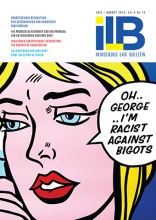Indigenous Law Bulletin 8(19)

EDITORIAL
The conversation on constitutional recognition has shifted somewhat since our last two special editions. In late June, the Joint Select Committee tabled their final report. This was followed by a meeting of 40 Aboriginal and Torres Strait Islander peoples with the Prime Minister and Opposition Leader, to discuss a way forward for a referendum.
Against this backdrop, a proposal put forth last year by Noel Pearson’s Cape York Institute is gaining traction. This proposal for an Indigenous parliamentary or advisory body to be set up within our Constitution was discussed at a recent symposium in Sydney—and is the topic discussed in this special edition.
The body appears to be a way forward in finding a substantial model of recognition. This is important, especially if the Expert Panel and Joint Select Committee’s recommendation of a new section (116A) prohibiting racial discrimination, doesn’t form part of the final proposal.
While the final model for change is not clear yet, what is very clear is that a minimalist approach to constitutional reform will not be accepted by Indigenous Australians. And nor should it be accepted by the rest of the population.
As I write this editorial, discussions have now turned to the idea of Indigenous only constitutional conventions. While a proposal asking the Federal Government to fund a series of Indigenous conventions was originally knocked back by Tony Abbott, the conventions now look set to go ahead under the administration of a referendum council. This is a positive development in the process, as it is important that Aboriginal and Torres Strait Islander peoples have the appropriate space to consider all of the options for constitutional reform.
Finally, this edition has been made possible with the generous support of UNSW Law. In addition to their ongoing in-kind support, the faculty has stepped in to fund this special edition—my final one as Editor.
I have thoroughly enjoyed editing the ILB and hope you have enjoyed reading it. My sincere thanks must go to: John Hewitt, Megan Davis, Leon Terrill, Marie Iskander, Kyllie Cripps, Melanie Simpson, Lauren Butterly, Wayne Metters and Kate Bonser. Thank you also to the dedicated members of the ILB Editorial Panel and ILC Steering Committee; and the very helpful staff at UNSW Law.
Editor
Rebecca Gallegos
CONTENTS
AN INDIGENOUS ADVISORY BODY: SOME QUESTIONS OF DESIGN
By Gabrielle Appleby
AN INDIGENOUS ADVISORY BODY: ADDRESSING THE CONCERNS ABOUT JUSTICIABILITY AND PARLIAMENTARY SOVEREIGNTY
By Anne Twomey
INDIGENOUS CONSTITUTIONAL RECOGNITION FROM THE POINT OF VIEW OF SELF-DETERMINATION AND ITS EXERCISE THROUGH DEMOCRATIC PARTICIPATION
By Megan Davis
CONSTITUTIONAL RECOGNITION, SELF-DETERMINATION AND AN INDIGENOUS REPRESENTATIVE BODY
By Melissa Castan
INDIGENOUS CONSTITUTIONAL RECOGNITION: THE CONCEPT OF CONSULTATION
By Cheryl Saunders
THE PROBLEM OF AUTHORITY AND THE PROPOSAL FOR AN INDIGENOUS ADVISORY BODY
By Fergal Davis
STATEMENT PRESENTED BY ABORIGINAL AND TORRES STRAIT ISLANDER ATTENDEES AT A MEETING HELD WITH THE PRIME MINISTER AND OPPOSITION LEADER ON CONSTITUTIONAL RECOGNITION
BOOK REVIEW: EVERYTHING YOU NEED TO KNOW ABOUT THE REFERENDUM TO RECOGNISE INDIGENOUS AUSTRALIANS BY MEGAN DAVIS AND GEORGE WILLIAMS
By Nicole Watson
Featured article:
